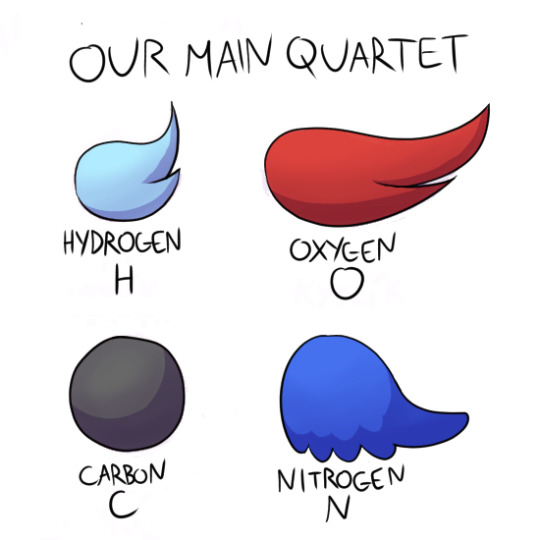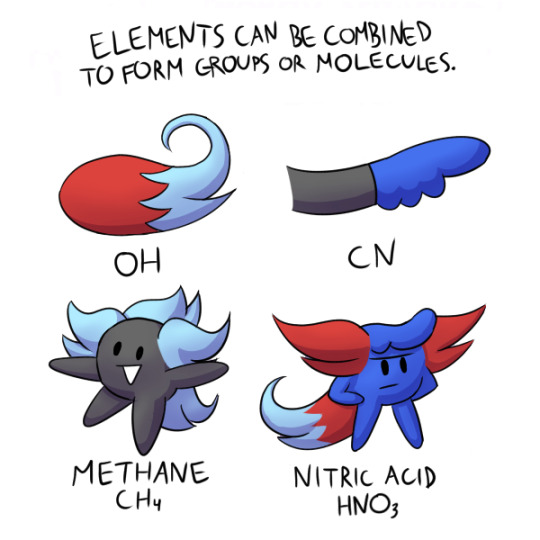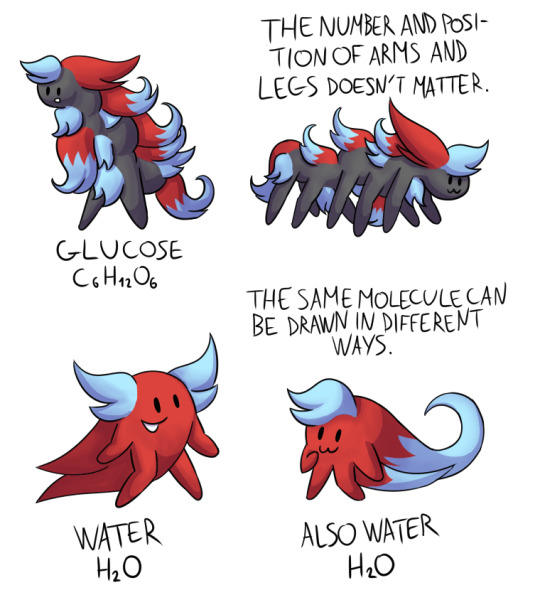Text
Hey everyone. I'm sorry for becoming so inactive for such a long time.
I had temporarily lost interest in this project (and by "temporarily" I mean a year and a half), but it has recently rekindled again. I have, however, decided to change my approach to posting my molecules.
Most of them won't be drawn with the same level of polish as they were in my first post. I've found that the time it takes to ink, color, and shade the molecules in that style impedes my main goal in the project: to experiment with different ideas on how to draw chemicals as creatures. The easiest method for me to do that is sketching on paper.
That's all I have to say for now. Stay tuned for more scrunklies!
0 notes
Text

Thank you, and you have asked a very good question! All of these are important things to notate, and I believe explaining them deserved its own post.
I think it's probably good to just talk about how I draw bonds in general. This is roughly how they evolved:

At first, I wanted to represent them with electrons tied together by a solid rectangular link. Then I thought it would be better to simplify them into rhombi, which I then changed to squares for greater elegancy. Those would be tied around a molecule on a kind of "belt", like this:

Theoretically, all of these are optional. If you removed them from the molecules, you'd still be able to calculate the bond number by counting the hydrogens, but seeing it explicitly drawn is just a lot faster and easier, and you don't have to rely on the preexisting knowledge of the atoms' valencies. For that reason, I usually don't mark single bonds, but make double and triple bonds explicit.
(You might notice that the triple bond looks a bit like a heart - at first, I didn't intend it and simply saw it as a way to draw it more compactly, but then I realized it somewhat fits! You could jokingly see it as two atoms in the bond being tied to each other by their strong "love". Additionally, I think that having a heart symbol in chemicals like carbon monoxide is just funny.)
I am aware that this way of visualizing them is imperfect - for instance, if a molecule rotates, it might be more difficult to see the notation if you only put it on one side. I am open to suggestions on how to improve my existing method, or ideas on how to change it to a completely different one.
As for cyclic compounds: I don't know what to say about the aliphatic ones, since they're not too different from non-cyclic molecules. But if a compound is aromatic, it gains a kind of "ring" inside the loop it makes:

While I am not sure if it's strictly necessary to simplify them, these rings occur in organic compounds very often, and I wouldn't be surprised if drawing them could get unwieldy. Perhaps there is a more efficient way to represent a phenyl that I hadn't thought about!
(You may be wondering why none of this is included in this post. The reason is that the images in it are a little outdated - I made them in 2022 for my teachers as a kind of introduction to my project. They don't contain the elements and concepts I have come up with only this year, and a few of the elements' appearances have been slightly altered. However, all of the core principles still apply, and there is a lot more information to catch up on rather than to forget, so viewing the post is still worth it!)
1 note
·
View note
Text
Last year, I had a radical idea that would change the way I think about chemistry forever.
What if molecules were a little bit fluffier?

It all started with me looking at the structural formulas in my schoolbooks. I was amused by how every element seemed to fill a different "role" in a molecule - carbon formed the skeleton, oxygen and nitrogen brought flavor, and hydrogen was there to fill all the bonds that weren't "used". They were almost like a bunch of tails attached to a central body.
But I felt that one thing was missing - and that was them being alive.

To describe how my system works, I have to outline the principles I follow.
The specific arrangement of the atoms is generally based on the molecule's 3D structure, though I sometimes make small changes from reality to make it resemble a character with human or animal traits.

One thing I'd like to ensure is the diversity of the molecules' appearances - I don't want their identities to be lost in B&W print or sketches. I also prefer avoiding symbols (chemical or alchemical), because I think they're overused and might also interfere with their facial expressions.

The faces and limbs serve exclusively to give them more character and expressive power - they don't define a molecule's composition or structure, though they may serve to help communicate a compound's "personality".
The reason behind the alternative representations of a molecule is to put emphasis on different aspects of it - e.g. if you want to look at water symmetrically as an oxygen with two hydrogens, it is better to use the representation on the left, but if you want to view it as a product of acid-base reactions, it is better to use the representation on the right.

I wanted a more visible way represent ionic bonding - most models simply show the ions disconnected from each other, and I thought making them more obvious would be a good idea. At first, I tried drawing it as an electron (held by the anion) that produces a rope which the cation is tied to, and then I noticed that it looks like a dog on a leash, which I thought was funny enough to draw like that.

I'm not sure if I will be able to fill out the entire periodic table - I don't think it's really even necessary. Most elements rarely occur in organic chemistry, which is what this system primarily focuses on. In any case, this project continues to evolve as new ideas flow into my head. Feel free to ask me any questions about it!
150 notes
·
View notes
Text
A little bit of info for the confused
This is a blog for posting parts of a project that I've been working on since October 2022, but which I have been contemplating as to how to share for a lot longer than I should. In the end, I have decided that it's probably good to let both my teachers and the internet know about it.
To answer questions others might have:
I am an artist with an interest in chemistry. I do not have any professional experience with the subject, and most of my knowledge comes from schoolbooks, Wikipedia articles, and educational Youtube channels such as NileRed.
I have a separate personal account on this website, but for the purposes of protecting my online identity from any people in real life who have already heard about this project, it will not be linked here.
I currently don't know what else could be asked, but feel free to inquire me about anything regarding my work!
2 notes
·
View notes